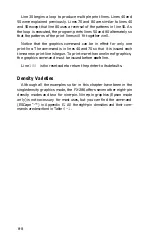
FX-286 can put a dot (dot positions), but only half of them can be used
on any one pass of the print head. Having twice as many possible dot
positions enables high-speed double-density designs to have a higher
resolution than single-density ones even though consecutive dots are
not used.
You are familiar with the command format that uses the ESCape
code and a letter, but FX-286 graphics commands in the Epson mode
can also be in the following format:
LPRINT CHR$(27)"*"CHR$(m)CHR$(n1)CHR$(n2);
with m being the mode number found in the left column of Table 6-1.
As usual, n1 and n2 reserve the number of columns for graphics. The
eight modes include seven densities, with two speeds for double-
density
Reassigning Code
The FX-286 (in the Epson mode only) has a graphics command that
changes one graphics mode to another. You can use it with many
commercial graphics software programs to change the density and
shape of your printouts. The code is ESCape "?s" n, where s is one of
the four alternate graphics codes (K, L, Y, or Z) and n is the number of
the new code (O-6).
For example, if you send the following code before you run a
graphics program, it will change every instance of mode “Y”
(high-speed double-density) to mode 5 (one-to-one).
LPRINT CHR$(27)"?Y"CHR$(
5)
As usual, this example is in BASIC, but you can send the code in
any programming language.
Even if you don’t know which code your graphics program uses, a
little experimentation should tell you whether the reassigning code can
improve your graphics printouts.
Column Reservation Numbers
Now that you’ve seen the rest of the eight-pin graphics densities and
the reassigning code, this section explains in more detail the part of the
graphics command that reserves the number of columns for graphics
(the numbers n1 and n2 in the examples).
6-10
Summary of Contents for FX-286 - Impact Printer
Page 1: ......
Page 2: ......
Page 35: ......
Page 40: ...2 4 ...
Page 48: ...3 8 ...
Page 56: ...4 8 ...
Page 91: ...6 16 ...
Page 118: ...C 10 ...
Page 133: ...Epson Mode Commands G 5 ...
Page 134: ...G 6 ...
Page 166: ...H 4 ...
Page 173: ...International Character Width Table Roman characters Italic characters I 7 ...
Page 174: ...I 8 ...
Page 180: ...J 6 ...
Page 181: ...IBM Proprinter Mode Commands J 7 ...
Page 182: ...J 8 ...
Page 202: ...J 28 ...
Page 208: ...K 6 ...
Page 216: ......
Page 220: ...IBM Mode See Appendix J for detailed explanations of codes Character Width Pitch ...
Page 221: ...Notes ...
Page 223: ......
















































